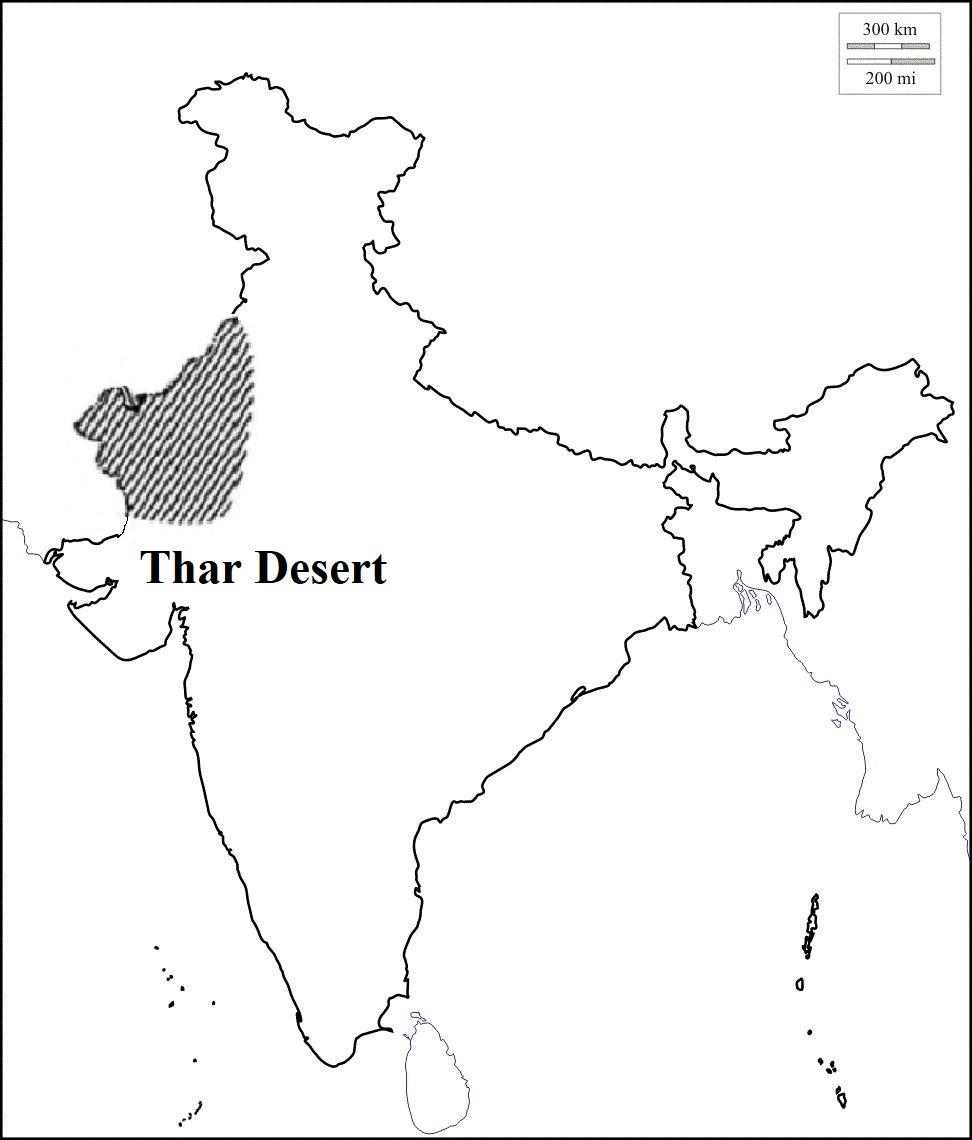
On the outline map of India provided, shade and label Thar Desert.
Answer
462.3k+ views
Hint: The Great Indian Desert is also known as the Thar Desert and is located in the Indian state of Rajasthan and the Pakistani states of Punjab and Sindh. A part of the desert is also located in the states of Gujarat and Haryana.
Complete answer: The Thar desert is an arid region in between the countries of India and Pakistan and also serves as a natural border between the two countries. The desert stretches over an area of 200000 square kilometres and is the 17th largest desert in the World. The desert is highly scarce in water availability and the only water sources are the natural and man-made ponds across the region. Due to this reason, the people generally live a nomadic life, which involves their constant movement from place to place. The Luni river is an important river in the Thar desert and it drains a large area of the desert. The other major river is Ghaggar which flows in the northern and eastern part of the desert. The Thar desert facilitates Kharif crops but with the use of modern technology, the different types of Rabi crops are also grown in the region. Many kinds of tourism, including eco-tourism have developed in the region. There are various saltwater lakes in the region, such as Sambhar Lake, Didwana Lake, etc. which provide a boost to the salt industry in the region. The Thar desert also finds mention in Vedic age maps, as the region fell beyond the Kamyak forests, the western boundary of the Kuru kingdom.

Note: The Thar desert is also known as the Cholistan Desert in Pakistan. It has been a battlefield for two Indo-Pakistan wars of 1965 and 1971. Two-thirds of the desert falls in the territory of India.
Complete answer: The Thar desert is an arid region in between the countries of India and Pakistan and also serves as a natural border between the two countries. The desert stretches over an area of 200000 square kilometres and is the 17th largest desert in the World. The desert is highly scarce in water availability and the only water sources are the natural and man-made ponds across the region. Due to this reason, the people generally live a nomadic life, which involves their constant movement from place to place. The Luni river is an important river in the Thar desert and it drains a large area of the desert. The other major river is Ghaggar which flows in the northern and eastern part of the desert. The Thar desert facilitates Kharif crops but with the use of modern technology, the different types of Rabi crops are also grown in the region. Many kinds of tourism, including eco-tourism have developed in the region. There are various saltwater lakes in the region, such as Sambhar Lake, Didwana Lake, etc. which provide a boost to the salt industry in the region. The Thar desert also finds mention in Vedic age maps, as the region fell beyond the Kamyak forests, the western boundary of the Kuru kingdom.

Note: The Thar desert is also known as the Cholistan Desert in Pakistan. It has been a battlefield for two Indo-Pakistan wars of 1965 and 1971. Two-thirds of the desert falls in the territory of India.
Recently Updated Pages
Master Class 9 General Knowledge: Engaging Questions & Answers for Success

Master Class 9 English: Engaging Questions & Answers for Success

Master Class 9 Science: Engaging Questions & Answers for Success

Master Class 9 Social Science: Engaging Questions & Answers for Success

Master Class 9 Maths: Engaging Questions & Answers for Success

Class 9 Question and Answer - Your Ultimate Solutions Guide

Trending doubts
Fill the blanks with the suitable prepositions 1 The class 9 english CBSE

The first successful textile mill was established in class 9 social science CBSE

Difference Between Plant Cell and Animal Cell

Given that HCF 306 657 9 find the LCM 306 657 class 9 maths CBSE

The highest mountain peak in India is A Kanchenjunga class 9 social science CBSE

What is the difference between Atleast and Atmost in class 9 maths CBSE




